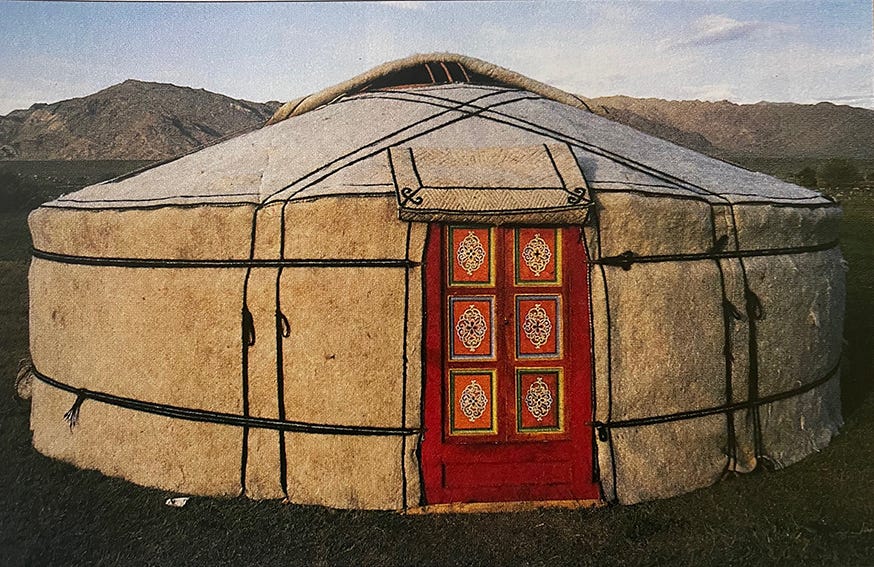In 2022, I had been working for months on a body of work that was painstaking in its process—lots of slow, tiny, almost endless gluing steps. I needed to offer my body a ‘counterweight’ activity in order to create some balance in my creative life.
So I started to make felt again.
The handmade felting process is very physical. it’s almost a whole-body workout because felt is created through friction—lots of rubbing and pounding—plus shock—alternating hot and cold water, which helps shrink the wool together.
Humans have been felting for at least six thousand years and handmade felt feels both primitive and sophisticated to me. Primal somehow.
Scholars surmise that one of our weary ancestors probably put bits of wool into their humble footwear to add softness or support. And then, after walking for hours, they sat down, took off their shoes, and pulled out a single sheet of felt. Aha!
Nomadic people in Central Asia and Mongolia have built portable homes with felt for centuries. Is this beautiful or what?

And can I just say—all our contemporary, human-engineered, weather-resistant, top of the line outdoor activewear materials are not actually better at protecting a person from the elements. In short, we haven’t improved on an ancient textile technique—maybe even the first textile technique—as a means for warmth and protection from rain or snow.
I freaking love that.
Enter Nuno
In the early nineties, Japanese fiber artists developed “nuno felting,” a process of combining wool with sheer or open weave fabrics (usually silk but not necessarily) which creates great textures in the wool and really expands one’s expressive options. (“Nuno” means fabric.)
Most nuno felters make scarves and garments, but I’ve been more focused on wall hangings and flags, as well as approaching the nuno felting process the same way one might paint or collage elements on paper or canvas.
For my silk, I like to hunt down scarves or garments at thrift stores and cut them up. This is a fun way to thrift because the clothing doesn’t have to fit me, I just have to like the pattern or material.
Last winter, I decided to try making a nuno felted abstract piece and embed it into an antique cabinet door. I love the shiny smoothness of the wood and its deep rich color against the warmth of the wool and the recycled silk bits.
Once I was done felting, it took me months to figure out how to successfully attach it to the cabinet door. Or maybe I should say ‘dare to attach it to the cabinet’ because I knew I had exactly one try to get it right.
I call this piece “The Road to Abiquiu.” I think of it as a kind of mysterious map for the spiritual journey inward.
Here’s a 30 second video on how it turned out:
(To see the detail closeup, click on the “full screen” icon in the bottom right corner, it helps a lot.)
Now that I’ve also just learned how to use a giant wet felting machine, I’m curious to see how I might combine these techniques, or if that’s even possible.
So, enough about me! What are you creating/working on/dreaming about this week? Please share in the comments, I’d love to know. (And it doesn’t have to be visual art.)
OR, maybe you have questions or comments about this piece in particular or nuno felting in general or anything else that came to mind reading this post?
Your Taos Moment of Zen
Yesterday, J. and I took our dog Lucy to one of our favorite spots. It was pretty quiet—just a few fisherman—I guess because of the SuperBowl. We were trotting along the river’s edge when I spotted an OTTER on the other side eating a fish. I mean, I could HEAR her eating a fish. HEAR her! I was mesmerized. Then her friend showed up. And then another one.
I’ve never seen wild otters in the flesh. It was glorious.
My camera doesn’t do closeups so well, but here’s a super short video of the beautiful view plus the otters near the rocks on the other side of the river.
This Week’s Inspiring Artist
I recently discovered Whitfield Lovell’s work. As someone who likes to turn my work into objects and/or incorporate objects into my work, I feel like I’ve just met my next teacher. OH. EM. GEE.
Some of his work, like this one below, is so right, I almost can’t stand it.
I found the image above on Pinterest, and while the corresponding article doesn’t share much information, there’s some great photos of more of his work.
Here’s a more informative link to an article about him in Hyperallergic, my favorite contemporary art magazine. The first image in that article is killer too.
I so appreciate that you have read all the way to the end. If you got this in your email, please forward this post to anyone you think might like it, I’d be forever grateful!















So happy to learn more about felting. I didn’t know yurts were made of felt! Fascinating how historians surmised that felt was discovered—haha. Agree that nothing beats good old fashioned wool for warmth and moisture wicking.
Your nuno felted panels are stunning!! Impressed by that intimidating installation.
Also… river otters. What a joyful omen…!
Are you a talented artist, or what? And your writing is terrific. I look forward to these posts, as each is a story journey with beautiful art. Thank you for sharing. 👍